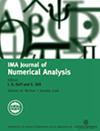平滑优化的几何整合方法:离散梯度法的基础
IF 2.3
2区 数学
Q1 MATHEMATICS, APPLIED
引用次数: 0
摘要
离散梯度法是一种几何积分技术,可以保留梯度流的耗散结构。由于函数值的单调衰减,离散梯度法非常适合一般的凸和非凸优化问题。通过选择不同的离散梯度,离散梯度法可以衍生出零阶算法和一阶算法。本文对离散梯度法进行了深入分析,为优化提供了坚实的理论基础。我们证明了离散梯度法在任意正时间步长下迭代的存在性,以及在某些情况下的唯一性,从而证明了离散梯度法的良好假设,并提出了一种求解相关离散梯度方程的高效方法。此外,我们还为凸目标建立了 $\text{O}(1/k)$收敛率,并在满足 Polyak-Łojasiewicz 不等式的情况下证明了线性收敛。分析针对三种离散梯度--冈萨雷斯离散梯度、均值离散梯度和伊藤阿部离散梯度--以及随机化伊藤阿部方法。我们通过各种数值实验对理论结果进行了说明,并进一步证明了这些方法在刚度方面的鲁棒性。本文章由计算机程序翻译,如有差异,请以英文原文为准。
A geometric integration approach to smooth optimization: foundations of the discrete gradient method
Discrete gradient methods are geometric integration techniques that can preserve the dissipative structure of gradient flows. Due to the monotonic decay of the function values, they are well suited for general convex and nonconvex optimization problems. Both zero- and first-order algorithms can be derived from the discrete gradient method by selecting different discrete gradients. In this paper, we present a thorough analysis of the discrete gradient method for optimization that provides a solid theoretical foundation. We show that the discrete gradient method is well-posed by proving the existence of iterates for any positive time step, as well as uniqueness in some cases, and propose an efficient method for solving the associated discrete gradient equation. Moreover, we establish an $\text{O}(1/k)$ convergence rate for convex objectives and prove linear convergence if instead the Polyak–Łojasiewicz inequality is satisfied. The analysis is carried out for three discrete gradients—the Gonzalez discrete gradient, the mean value discrete gradient, and the Itoh–Abe discrete gradient—as well as for a randomised Itoh–Abe method. Our theoretical results are illustrated with a variety of numerical experiments, and we furthermore demonstrate that the methods are robust with respect to stiffness.
求助全文
通过发布文献求助,成功后即可免费获取论文全文。
去求助
来源期刊
CiteScore
5.30
自引率
4.80%
发文量
79
审稿时长
6-12 weeks
期刊介绍:
The IMA Journal of Numerical Analysis (IMAJNA) publishes original contributions to all fields of numerical analysis; articles will be accepted which treat the theory, development or use of practical algorithms and interactions between these aspects. Occasional survey articles are also published.

 求助内容:
求助内容: 应助结果提醒方式:
应助结果提醒方式:


